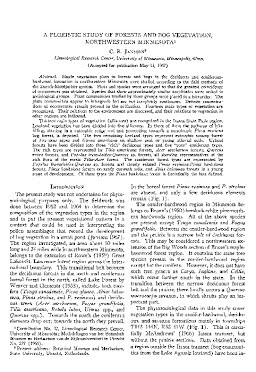1967
A floristic study of forests and bog vegetation, Northwestern Minnesota
Publication
Publication
Mededelingen van het Botanisch Museum en Herbarium van de Rijksuniversiteit te Utrecht , Volume 277 - Issue 1 p. 751- 765
Single vegetation plots in forests and bogs in the deciduous and coniferoushardwood formation in northwestern Minnesota were studied according to the field methods of the Zürich-Montpellier system. Plots and species were arranged so that the greatest coincidence of occurrences was obtained. Species that show approximately similar amplitudes were united in sociological groups. Plant communities typified by these groups were placed in a hierarchy. The plant communities appear to intergrade but are not completely continuous. Definite concentrations of occurrences remain present in the ordination. Fourteen main types of vegetation are recognized. Their relations to the environment are discussed, and their relations to vegetation in other regions are indicated. Thirteen main types of vegetation (alliances) are recognized in the Itasca State Park region. Lowland vegetation has been divided into five alliances. In three of them the pathway of lake filling, starting in a eutrophic sedge mat and proceeding towards a mesotropic Picea mariana bog forest, is depicted. The two remaining lowland types represent eutrophic swamp forest of Fraxinus nigra and Ulmus americana on shallow peat or young alluvial soils. Upland forests have been divided into three “rich” deciduous types and five “poor” coniferous types. The rich types are represented by Tilia americana forests, Acer saccharum forests, Quercus rubra forests, and Populus tremuloides-Quercus sp. forests, all showing representatives of the rich flora of the mesic Tilia-Acer forest. The coniferous forest types are represented by Populus tremuloides-Quercus sp. forests and closely related Pinus resinosa-Pinus banksiana forests, Pinus banksiana forests on sandy outwash soils, and Abies balsamea forests in a young stage of development. Of these types the Pinus banksiana forest is floristically the best defined.
| Additional Metadata | |
|---|---|
| Mededelingen van het Botanisch Museum en Herbarium van de Rijksuniversiteit te Utrecht | |
| Released under the CC-BY 4.0 ("Attribution") License | |
| Organisation | Naturalis journals & series |
|
Janssen, C. R. (1967). A floristic study of forests and bog vegetation, Northwestern Minnesota. Mededelingen van het Botanisch Museum en Herbarium van de Rijksuniversiteit te Utrecht, 277(1), 751–765. |
|
